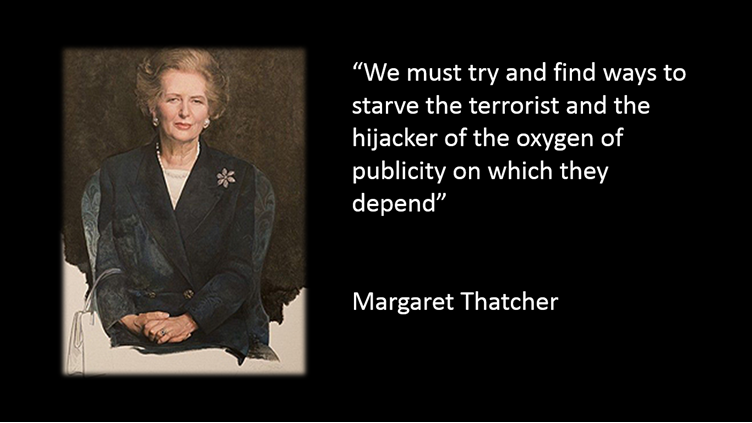Every time Islamic State releases a video, editors are acutely aware that they are being invited to a Danse Macabre. The finely calibrated degree of violence within the video is matched with high production values to create maximum impact. A recent video released by Isis was 11 minutes long and featured a man, in military-style fatigues speaking with an apparent English accent, who delivered a “message” to David Cameron before five men, described by Isis as spies, were executed.
(Article by Chriss Elliot, republished from http://www.theguardian.com/commentisfree/2016/jan/11/coverage-of-isis-videos-should-be-about-news-not-propaganda)
That video made the front page lead in the Guardian on 4 January, accompanied by a picture of the man, which dominated the page. There was also a photograph of a small boy, who appeared in the video and spoke in English, threatening to kill the kuffar [non-believers]. His face was pixelated.
While the readers’ editor has had few complaints about our coverage here is one from a reader who saw the story on the Guardian’s website and articulates the fundamental dilemma:
“Your homepage at 2pm contained no less than four articles about the Isis propaganda video, with three stills from said video. It makes one wonder whether the Guardian really reflects on its role as a news outlet and how it can avoid becoming a propaganda carrier for groups like Isis, and with that avoid giving that group the oxygen of publicity. In this case it seems like the Guardian got that balance wrong. In general you should think very, very hard about widely disseminating videos designed to spread fear, and whose main way to get traction is to be published by news outlets the world over. I think that Isis videos should be largely ignored and if giving them attention is deemed in the public interest, they should be heavily contextualised.”
It is not a new dilemma. The phrase “the oxygen of publicity” was first used by Margaret Thatcher on 15 July 1985 in a speech to the American Bar Association. She said: “In this evil strategy, the actions of the media are all important. For newspapers and television, acts of terrorism inevitably make good copy and compelling viewing. The hijacker and the terrorist thrive on publicity: without it, their activities and their influence are sharply curtailed. There is a fearful progression, which the terrorists exploit to the full. They see how acts of violence and horror dominate the newspaper columns and television screens of the free world. They see how that coverage creates a natural wave of sympathy for the victims and pressure to end their plight no matter what the consequence. And the terrorists exploit it.
“Violence and atrocity command attention. We must not play into their hands … we must try to find ways to starve the terrorist and the hijacker of the oxygen of publicity on which they depend.” That resulted in a broadcast ban – newspapers could print statements from restricted groups’ spokesmen but broadcasters could not use their voices on screen – that lasted from 1988 to 1994. As my colleague Owen Bowcott wrote in 2014: “Sinn Féin was the main target of the restrictions but they also covered 10 republican and loyalist paramilitary groups, including the Irish National Liberation Army (INLA), the Ulster Volunteer force (UVF) and the Ulster Defence Association (UDA) … As the peace process gathered pace, the anomaly of Gerry Adams being interviewed by the world’s media and his words broadcast in every country apart from the UK – where they had to be re-voiced – became increasingly difficult to sustain. The Westminster ban was lifted in September 1994, weeks after the IRA declared its first ceasefire.”
Then the delineation of print and broadcasting was much clearer; now the web would render such a ban meaningless, quite apart from the issue of the brake on the freedom of the press.
These are important events, so how do Guardian journalists attempt to focus on the news report rather than the propaganda?
First, there is a simple set of guidelines used by editors when a video involving Isis killings is released:
• Do not use the video and avoid pictures that glamorise the perpetrator – ie posing with the hostages or with weapons. Use audio sparingly.
• Only use a closely cropped still picture of the hostage/s from the video and use downpage in the web article to avoid it appearing on fronts.
• The main image should ideally be a picture of the hostage/s in another context.
One of those responsible for drawing up the guidelines is Jamie Wilson, the Guardian’s head of international news. He said: “I think we do contextualise, I don’t think we are being hoodwinked. We know what they are doing and that there is a Russian version, a French version of these videos, we know it’s propaganda, and we make that very clear in all our coverage.
“On Monday we used large pictures of the hostages and I think that was quite moving. We used an image of the Briton [talking to camera] because he is new and some people may be able to identify him from his eyes.
“It is propaganda but it is also newsworthy when a man believed to be British is involved in murdering five people in the name of Isis and is making direct threats to the UK; it has a news value we cannot ignore.
“We wanted to avoid glorifying the act. We were very careful with images. We don’t show the weapon and we don’t show the perpetrator and the victim in the same shot.
“The guidelines are not hard and fast, we have to review them on a case by case basis.”
The Guardian was one of the only newspapers to pixelate the child’s face to hide his identity, because he is incapable of giving consent for the photograph and the use of it was clearly exploitative.
While I think overall the week’s coverage reflected good use of the guidelines, the size of the image of the Isis “English” recruit on last Monday’s print front page and on the website’s homepage did tend to glamorise the man. However, few would suggest it is easy to reconcile the need to give due weight to the story and deny the aims of Isis. Undoubtedly the guidelines will have to be reviewed as groups such as Isis change their propaganda tactics. Sadly, there is no sign that the videos will stop coming.


